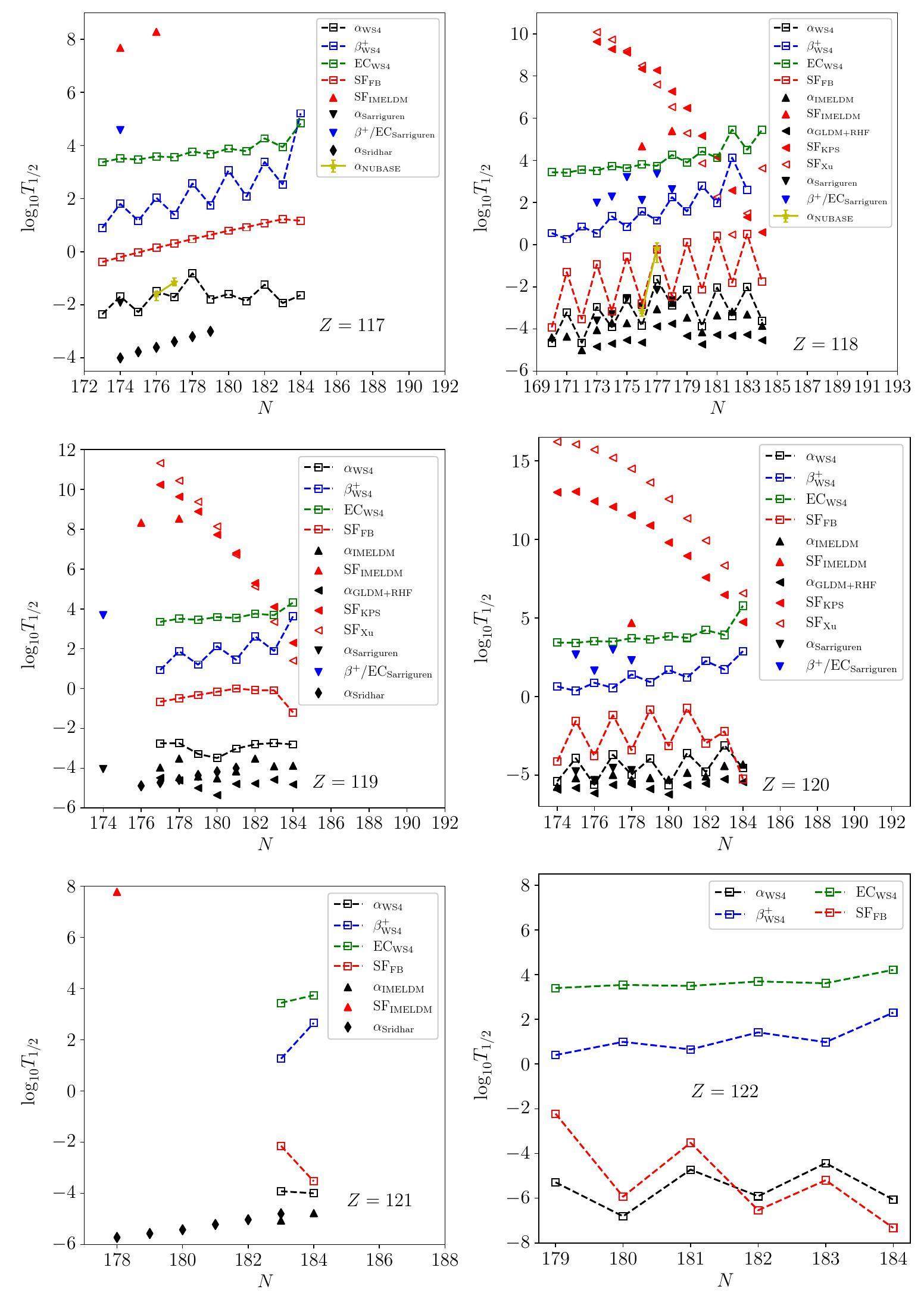Introduction
Limitations of the nuclear landscape [1, 2] have always been an intriguing topic. Exotic nuclear properties, for example, the shell evolution [3-6], 4n resonant state [7, 8], and 4p unbound state [9], emerge at the limits of nuclear stability. The discovery of new elements (nuclides) involves the following three problems: production, separation, and identification [10]. Because the nuclei are unstable and have relatively short half-lives, appropriate probes must be utilized. Characteristic decay modes [10, 11] are commonly employed as a probe to signal the existence of exotic nuclei. Therefore, investigating and predicting the dominant decay modes of the unknown nuclides is crucial. The nuclear binding energy and half-life are key parameters for determining the decay mode of a nucleus. The former measures the stability of nuclides by using energy criteria, and the latter describes the possibility of decay.
Both microscopic and macroscopic methods have been used to study the nuclear binding energy [12-16] and partial half-life of each decay channel, including α decay [17-19], β decay [20, 21], spontaneous fission [22, 23], protons emission [25] and neutron emission [24], etc. Microscopic theories begin with nucleon–nucleon interactions, which can be based on either realistic or phenomenological models. The macroscopic theory uses selected variables with physical considerations to construct semi-empirical formulas and fit the experimental data, and it entails the risk of overfitting and inappropriate parameters. In addition, exotic nuclei may significantly deviate from the general fitting and be identified as outliers. Decreasing the deviation between theoretical predictions and the observed results remains a critical issue.
With advances in computing and storage, efficacious machine learning algorithms with diverse applications have been proposed [26, 27], e.g., nuclear properties [28-30], fission yields [31-35], spectra decomposition [36], solving Schrödinger equation [37], and other nuclear techniques [38, 39]. As summarized in a recent colloquium, estimating the residuals of nuclear properties using machine learning algorithms is a powerful strategy [40]. A neural network has been used to compensate for the residuals of nuclear masses [41-43] and nuclear charge radii [44-46]; this has been achieved through structural optimization and careful selection of the input parameters with definite physical interpretations. The applicability of the decision tree (DT) has been verified via training and testing with residuals of the binding energies [47]. However, random forest (RF) [48] algorithm, developed from the DT algorithm, has not been tested for determining the nuclear mass or the partial half-life of a specific decay channel; in this regard, semi-empirical formulas have suggested several major components but with residuals. Machine learning algorithms can include possible features to realize the training for residuals, whereas RF, with bootstrap sampling, not only avoids overfitting but also considers the correlation between the data combinations and several features. Thus, RF exhibits increased robustness and is conducive to extrapolation. The amount of computation increasing in accordance with the number of trees in the forest and size of the dataset, as well as the difficulty of model interpretability, may limit its applications.
This study entailed the application of an RF machine learning algorithm to analyze the major decay modes of heavy and superheavy nuclei. The competition between α decay, β decay, and spontaneous fission (SF) of new elements, as well as the possible long-lived island in the superheavy region were examined.
Method
This study focused on the
Decay Half-life Formulas
The universal decay law (UDL) [49, 50],
A three-parameter formula (denoted as SF3) was used for the SF as follows:
| a (log10BGT) | b | c | RMSE | RMSERF,WS4 | RMSERF,UNEDF0 | |
|---|---|---|---|---|---|---|
| UDL | 0.407 | -0.382 | -23.896 | 0.883 | 0.598 | 0.669 |
| SF3 (Z<104) | -1.129 | -6997.113 | 79.803 | 3.070 | 1.195 | 1.195 |
| SF3 (Z≥104) | -1.363 | -13272.729 | 113.415 | 1.267 | 0.825 | 0.825 |
| Eq. (3) |
1.378 | - | - | 1.957 | 0.439 | 0.437 |
| Eq. (3) |
-1.819 | - | - | 1.451 | 0.656 | 0.667 |
| Eq. (3)EC | -2.112 | - | - | 2.360 | 0.971 | 0.996 |
The β decay half-life was estimated using the formula given in Refs. [56, 21]. Assuming that the ground state β decay is an effective Gamow–Teller (GT) transition, the partial half-life can be expressed as follows:
Random Forest Method
RF is a fusion of the DT and bootstrap algorithms. DT is a non-parametric supervised learning algorithm. For a dataset consisting of S samples of I features (variables)
Bootstrap is a statistical method based on the concept of random resampling with replacement, through which possible combinations and weights of data are automatically considered [58, 59]. Each time a new dataset is obtained, a new DT is trained and used to predict the object of each sample in the entire dataset. By repeating this process M times, a forest of M trees is obtained. The final predicted value of the object for a sample is the average of the results calculated by all the trees in the forest. Because each tree is trained by part of the samples in the dataset, the value for each sample predicted by the forest is an average of the interpolation and extrapolation; this decreases the divergence when the calculation is implemented for the unmeasured nuclei. The open-source Python library scikit-learn [60] was used for machine learning. The forest was assumed to be composed of 105 trees so as to decrease the dispersion of the RMSE in this study.
Results and Discussion
The residuals of the decay formulas of α decay, β- decay, β+ decay, and EC were trained using the RF with features Z, N, A, the odevity of Z and N, and the decay energy. Because the decay energy cannot be defined for the SF, the fission barrier (FB) obtained from Ref. [61] was used to replace the decay energy in the feature set to consider the deformation effect. The number of leaves chosen for this study was 11, which was the same as that used for training the binding energy in this region in our previous study [62]. Fig. 1 compares the residuals of these decay formulas before and after RF training. Two conditions were assumed to determine the outliers: 1) located outside the dashed line with the corresponding color, which indicates that the scatter deviates by twice the RMSE from the experimental
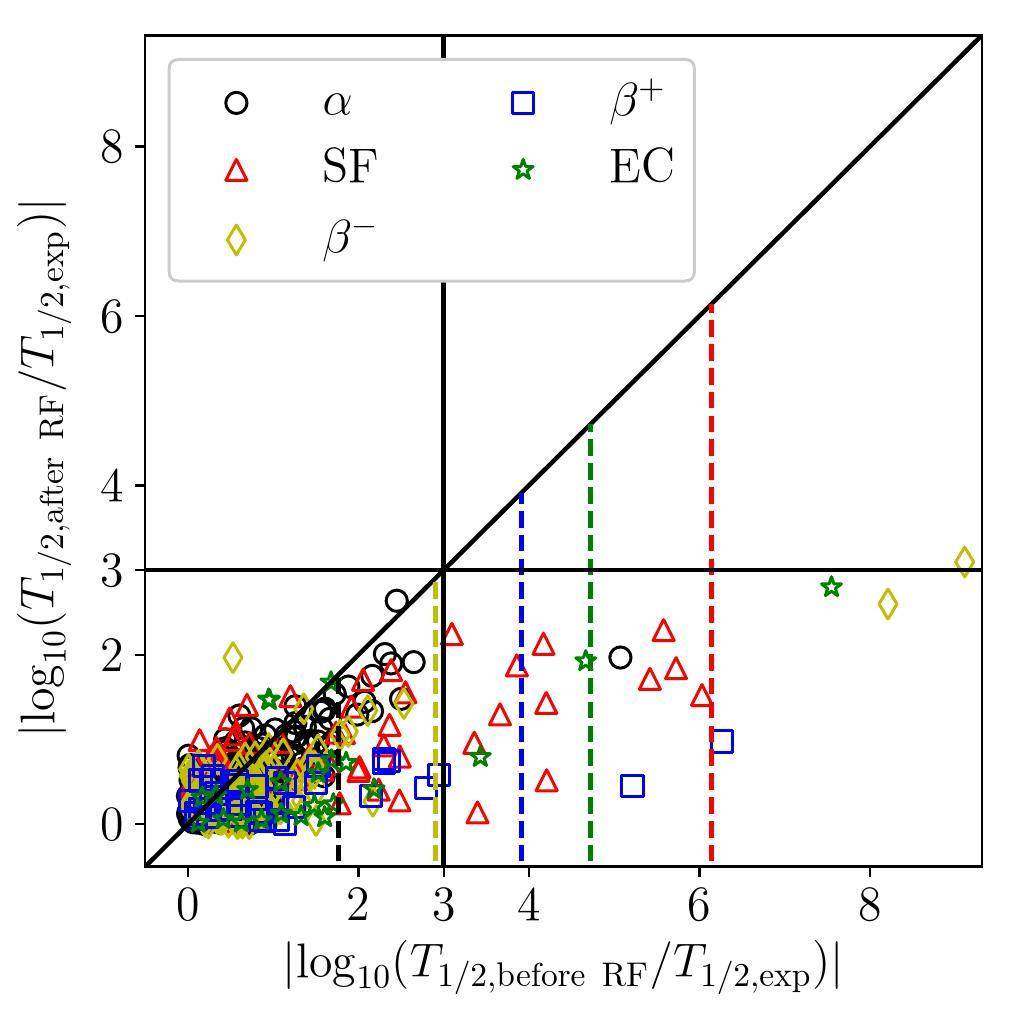
In total, 445 nuclides with measured partial half-lives and branch ratios of the five decay modes were obtained from NUBASE2020 [63]. The dominant decay modes and partial half-lives of the nuclides are illustrated in Fig. 2(a,b). A long-lived α decay valley from
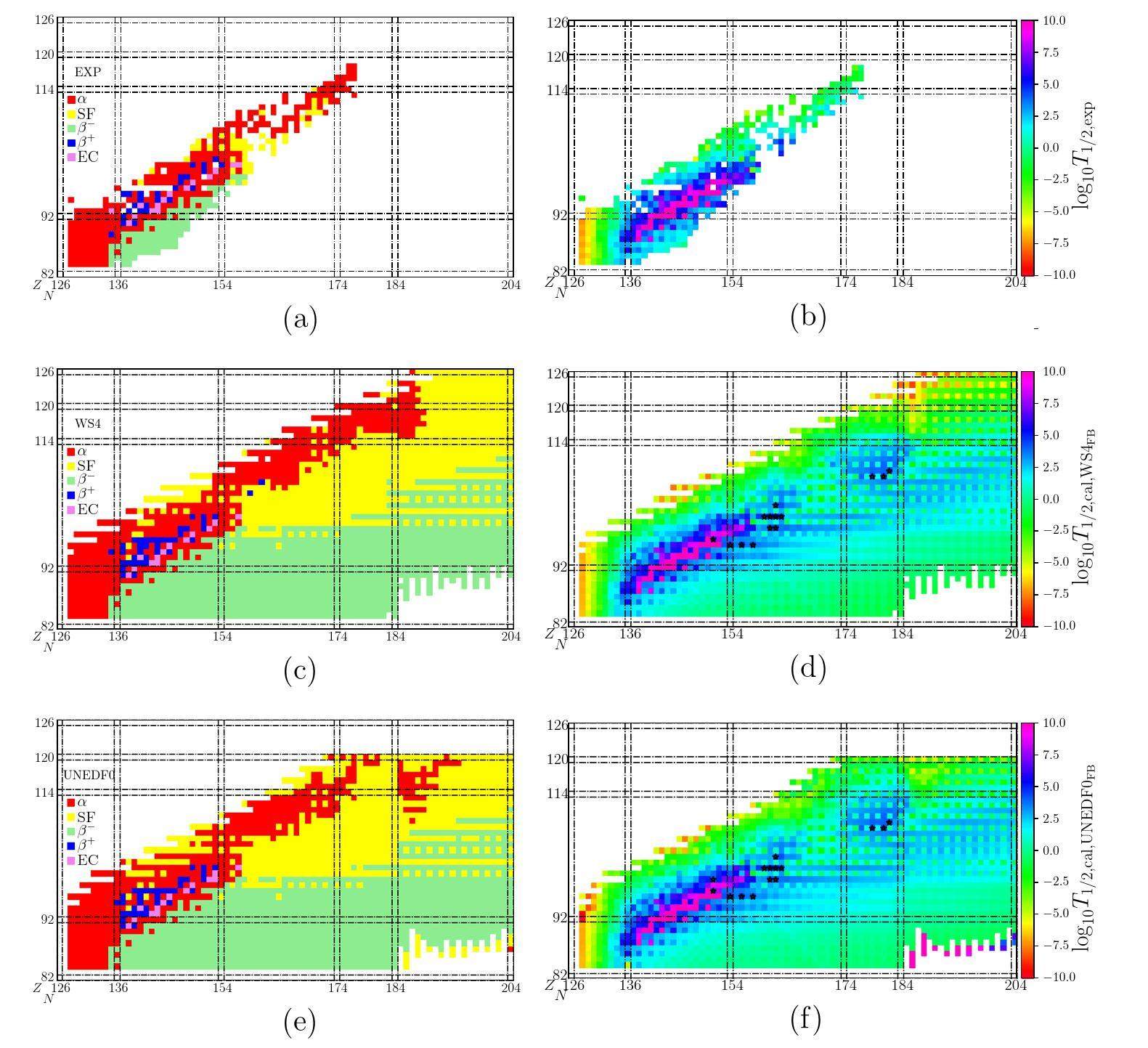
Among the 445 nuclides considered, 341 (104) nuclides had known (unknown) corresponding decay energies. The nuclides with unmeasured masses were calculated using WS4 [12] and UNEDF0 [13] to estimate the partial half-lives. The results of the RF are presented in Fig. 2(c–f). The calculated results sufficiently agree with the experimental results because the dominant decay mode is correctly described for 431 and 427 (96.9% and 96.0%) nuclei when the RMSE of
The N-Z=48 chain, where the partial half-lives of the α decay, β decay, and SF are comparable, was used for a specific comparison. The results of the density-dependent cluster model within the anisotropic deformation-dependent surface diffuseness [64], Royer formula [66], modified Swiatecki’s formula [22], nuclear liquid drop model [23], and deformed self-consistent Hartree–Fock mean-field with Skyrme forces and pairing correlations [66] were compared with the experimental values; the results are presented in Table 2. The models afforded similar results and deduced a consistent dominant decay mode.
| Nucl. | |||||||||||||
|---|---|---|---|---|---|---|---|---|---|---|---|---|---|
| 244Cf | 3.193 | 3.298 | 3.009 | 3.334 | - | - | - | - | - | 3.670 | - | 4.426 | 3.403 |
| 246Es | 3.658 | 4.464 | - | - | - | - | - | - | 2.698 | - | 2.213 | - | - |
| 248Fm | 1.538 | 1.637 | 3.358 | 1.731 | 4.538 | 4.678 | 4.739 | 5.069 | - | - | - | - | 2.025 |
| 250Md | 2.887 | 2.567 | - | - | - | - | - | - | 1.764 | - | 1.809 | - | - |
| 252No | 0.562 | 0.541 | 0.253 | 0.675 | 0.897 | 1.799 | 1.499 | 2.119 | 2.351 | - | 2.223 | - | 1.822 |
| 254Lr | 1.224 | 1.159 | - | - | - | - | - | - | 1.627 | - | 1.577 | - | - |
| 256Rf | 0.328 | 0.082 | -0.198 | 0.250 | -2.179 | -1.382 | -1.071 | 0.519 | - | - | - | - | 1.898 |
| 258Db | 0.530 | 0.037 | - | - | - | - | - | - | 0.780 | - | 1.349 | - | - |
| 260Sg | -1.768 | -1.940 | -2.300 | - | -2.157 | -2.862 | -2.811 | -2.301 | - | - | - | - | - |
The accuracy of the obtained energy is crucial for half-life calculations. If the calculated energies of WS4 and UNEDF0 replace all the experimental energies, the number with a consistent decay mode compared to the experiment reduces to 72.6% and 64%, respectively, and the RMSE of log10T1/2 increases to 2.07 and 2.64. The difference in the results obtained using the energies of the two models is owing to the accuracy because the RMSE of the mass of WS4 is approximately 0.3 MeV [12], whereas that of UNEDF0 is approximately 1.45 MeV [13]. This also leads to differences during extrapolation. The consistency rate of the dominant decay mode between the energies calculated using these two models decreases from 82.2% to 66.2%. More accurate and precise measurements of the decay energy will aid in theoretical predictions. In addition, WS4 and UNEDF0 may lose their predictive power after training with machine learning. Training the WS4 and UNEDF0 binding energies with features Z, N, δ, and P, which sufficiently describe the residuals in Ref. [42], improves the energy description but decreases the consistency in the dominant decay mode by several percent, which is considerable compared to the 23.4% rate of the theoretical energies among all nuclides (104/445).
The SF is important for investigating the half-lives of superheavy nuclei. As shown in Fig. 2(c, e), the dominant decay mode of the unknown nuclides is determined in accordance with the competition between the SF, α decay, and β- decay. The major competition is between the SF and β- decay for neutron-rich nuclides, and between the SF and α decay for neutron-deficient nuclides. Existing experimental data demonstrates a long-lived α decay region from
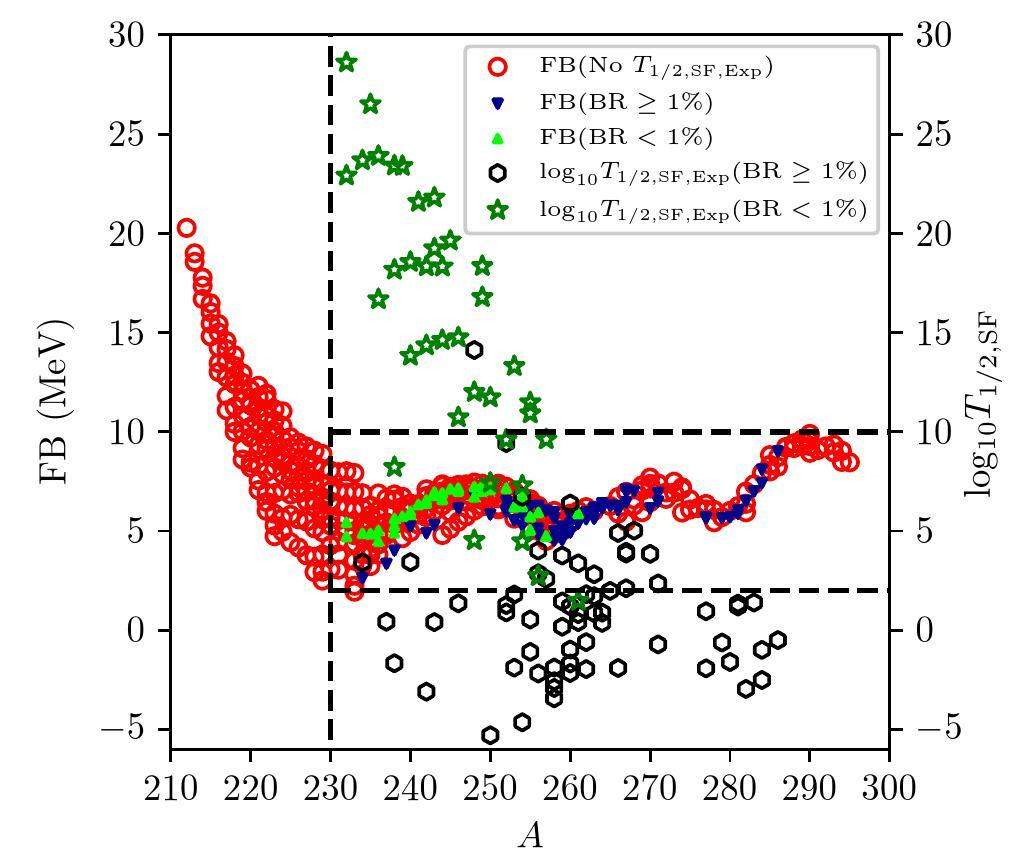
The nuclides with partial half-lives predicted to be longer than 104 s are marked with stars in Figs. 2(d, f), which suggests 250,252,254Cm, 260, 261Es, 261-264Md, and 265Lr for future measurements. No experimental value of the half-life of 250Cm was suggested in NUBASE2020 and was thus extrapolated in this study. In the NNDC, SF was shown to be the dominant decay mode, and its half-life was recommended to be 8300 years, which is relatively long. Although the calculations in this study underestimate the NNDC value, the long half-life and dominant decay mode are reproduced. In addition, the upper limit of the half-life of 252Cm was proposed to be two days in Ref. [65], which was not updated since then (1966), whereas the current study estimates a half-life of 1.43 days. No experimental half-lives were previously reported for 260, 261Es, 261-264Md, and 265Lr. However, their nearby isotopes have long half-lives, such as 257Es (7.7 days), 260Md (31.8 days), 259Md (1.6 h), 258Md (51.5 days), 257Md (5.52 h), and 266Lr (11 h). Moreover, the Es, Md, and Lr isotopes are located in the extension of the narrow long-lived region from 226Ra to 251Cf, substantiating that the Es, Md, and Lr isotopes are candidates with long partial half-lives. Obtaining more measurements is also suggested; for example, the 252Cm data has not been updated for more than 50 years.
A comparison of all the possible decay channels is limited by the accurate description of each channel and the observed data; note, the SF mechanism remains unclear, such as its dependence on the FB or deformation. The effect of the quadrupole deformation parameter (ε2) [15] on the half-life estimation was then investigated. If the FB is replaced with ε2 during RF training, more nuclides are predicted to have longer half-lives. Further investigations should be conducted to understand the dominant factors that contribute to the half-life of SF. The FB combines the contributions of multipole deformations and thus presents a stronger quantum effect, as shown in Fig. 2(d, f), compared to ε2. Fig. 3 demonstrates that the FB increases when Z is large; this indicates the competition between the FB and Coulomb repulsion in superheavy nuclides.
The extrapolation stops at the single-neutron (proton) and two-neutron (two-proton) drip lines. The UNEDF0 data set stops at Z=120. From the existing region to the neutron-deficient side, the α decay and SF are predicted to compete. On the neutron-rich side, the calculations predict the β- decay as the dominant mode, whereas the SF competes for specific nuclides. The latest results of most theoretical calculations of the partial half-lives [17-20, 22, 23, 66-70] indicate that the α decay mode is dominant for new elements at
The T1/2, α values predicted in this study were longer than those indicated in Refs. [18-20]; this does not change the dominant decay mode of odd-Z isotopes but enhances the competition of SF in even-Z isotopes. Furthermore, the prediction in this study demonstrated a strong odd–even staggering of T1/2, SF of even-Z isotopes. In other words, the T1/2, SF value of even–even nuclei is several times shorter than its two isotopic neighbors, which differs from the weak or unpredicted odd–even staggering effect obtained by other SF models shown in Fig. 4. Notably, all measured T1/2, SF values of the even-Z isotopes demonstrate such odd–even staggering. Fig. 5 illustrates
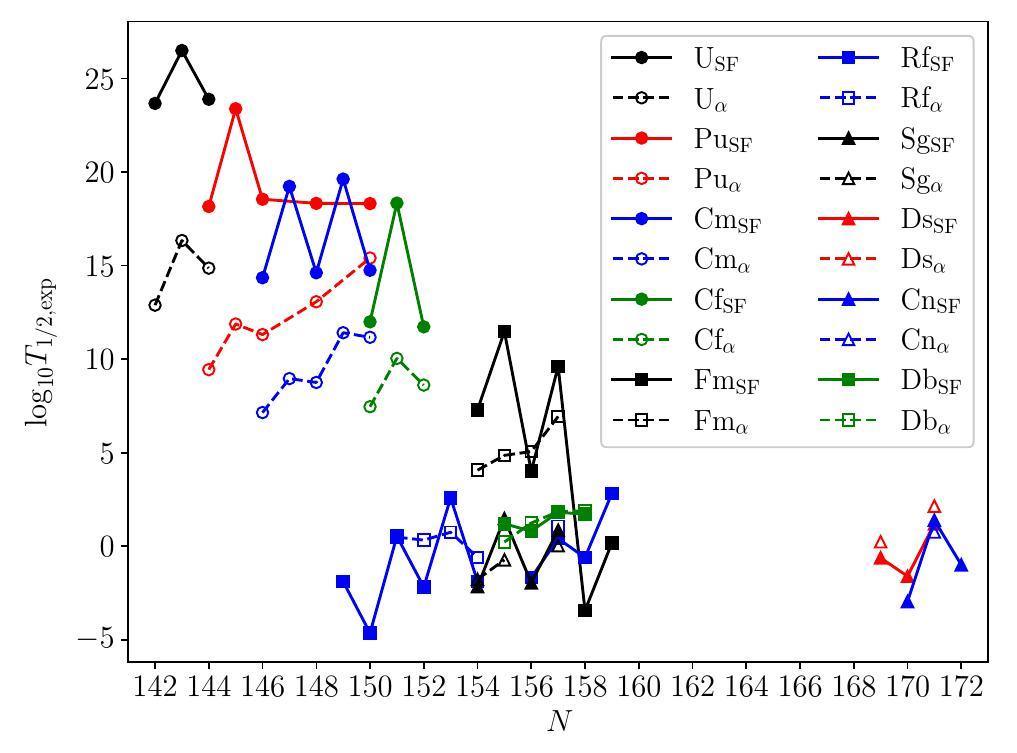
Summary
In this study, the decay modes of superheavy nuclei were investigated using the RF algorithm. The partial half-lives of α decay, β- decay, β+ decay, as well as EC, and SF were studied and compared. The dominance of α decay in the neutron-deficient region was relatively evident. β- decay is predicted to be dominant in the neutron-rich regions. The SF contributes to a long-lived circle at the southwest corner of Z=114 and N=184. A more accurate and precise measurement of the nuclear mass and decay energy can improve the prediction of the decay mode. The odd–even effect of the SF was observed in even-Z nuclides. Combined with the strong Coulomb repulsion, the SF and α decay became competitive in even–even nuclides. Thus, the α decay is suggested to be a key probe of isotopes with Z=119 and 121, whereas the competition of SF should be considered in even–even isotopes with Z=120 and 122.
250, 252, 254Cm, 260, 261Es, 261-264Md, and 265Lr with half-lives predicted to be longer than 104 s were suggested for future measurements. The SF, influenced by the fission barrier and Coulomb repulsion, leads to a long-lived region during extrapolation. The results of this study indicate that research regarding SF, especially beyond 286Fl, which is currently the heaviest nuclide with a significant SF branch ratio, is critical for performing studies on new facilities, such as CAFE2 and SHANS2 in Lanzhou.
The limits of nuclear mass and charge
. Nat. Phys. 14, 537 (2018). https://doi.org/10.1038/s41567-018-0163-3The limits of the nuclear landscape
. Nature 486, 509 (2012). https://doi.org/10.1038/nature11188Evolution of shell structure in exotic nuclei
. Rev. Mod. Phys. 92, 015002 (2020). https://doi.org/10.1103/RevModPhys.92.015002Novel features of nuclear forces and shell evolution in exotic nuclei
. Phys. Rev. Lett. 104, 012501 (2010). https://doi.org/10.1103/PhysRevLett.104.012501New magic number, N=16, near the neutron drip line
. Phys. Rev. Lett. 84, 5493 (2000). https://doi.org/10.1103/PhysRevLett.84.5493Shell evolution and nuclear forces
. Phys. Lett. B 686, 109 (2010). https://doi.org/10.1016/j.physletb.2010.02.051Observation of a correlated free four-neutron system
. Nature 606, 678 (2022). https://doi.org/10.1038/s41586-022-04827-6A binitio no-core Gamow shell-model calculations of multineutron systems
. Phys. Rev. C 100, 054313 (2019). https://doi.org/10.1103/PhysRevC.100.054313First observation of the four-proton unbound nucleus 18Mg
. Phys. Rev. Lett. 127, 262502 (2021). https://doi.org/10.1103/PhysRevLett.127.262502The discovery of the heaviest elements
. Rev. Mod. Phys. 72, 733 (2000). https://doi.org/10.1103/RevModPhys.72.733Colloquium: Superheavy elements: Oganesson and beyond
. Rev. Mod. Phys. 91, 011001 (2019). https://doi.org/10.1103/RevModPhys.91.011001Surface diffuseness correction in global mass formula
. Phys. Lett. B 734, 215 (2014). https://doi.org/10.1016/j.physletb.2014.05.049Nuclear energy density optimization
. Phys. Rev. C 82, 024313 (2010). https://doi.org/10.1103/PhysRevC.82.024313Development of the semiempirical droplet model
. At. Data Nucl. Data Tables 17, 411 (1976). https://doi.org/10.1016/0092-640X(76)90030-9Nuclear ground-state masses and deformations: FRDM(2012)
. Atom. Data Nucl. Data 109-110, 1 (2016). https://doi.org/10.1016/j.adt.2015.10.002Hartree-Fock-Bogoliubov nuclear mass model with 0.50 MeV accuracy based on standard forms of Skyrme and pairing functionals
. Phys. Rev. C 88, 061302 (2013). https://doi.org/10.1103/PhysRevC.88.061302A new empirical formula for α–decay half-life and decay chains of Z = 120 isotopes
. Phys. Scr. 96, 125304 (2021). https://doi.org/10.1088/1402-4896/ac1a4dImproved effective liquid drop model for α–decay half-lives
. Nucl. Phys. A 1017, 122341 (2022). https://doi.org/10.1016/j.nuclphysa.2021.122341Research on α–decay for the superheavy nuclei with Z= 118–120
. Chinese Phys. C 46, 054102 (2022). https://doi.org/10.1088/1674-1137/ac4c3aSelf-consistent calculations of electron-capture decays in Z = 118, 119, and 120 superheavy isotopes
. Phys. Lett. B 815, 136149 (2021). https://doi.org/10.1016/j.physletb.2021.136149Investigation of β-–decay half-life and delayed neutron emission with uncertainty analysis
. Nucl. Sci. Tech. 34, 9 (2023). https://doi.org/10.1007/s41365-022-01153-4Competition between α–decay and spontaneous fission for superheavy nuclei
. J. Phys. G Nucl. Part. Phys. 42, 085101 (2015). https://doi.org/10.1088/0954-3899/42/8/085101Search for decay modes of heavy and superheavy nuclei
. Chinese Phys. C 43, 074102 (2019). https://doi.org/10.1088/1674-1137/43/7/074102Theoretical description of the decay width of neutron emission in light nuclei
(in Chinese). Chin. Sci. Bull. 67, 2782-2789 (2022). https://doi.org/10.1360/TB-2022-0151Extended R-matrix description of two-proton radioactivity
. Phys. Lett. B 838, 137740 (2023). https://doi.org/10.1016/j.physletb.2023.137740A high-bias, low-variance introduction to Machine Learning for physicists
. Phys. Rep. 810, 1 (2019). https://doi.org/10.1016/j.physrep.2019.03.001High‐energy nuclear physics meets machine learning
. Nucl. Sci. Tech. 34, 88 (2023). https://doi.org/10.1007/s41365-023-01233-zExamination of machine learning for assessing physical effects: Learning the relativistic continuum mass table with kernel ridge regression
. Chinese Phys. C 47, 074108 (2023). https://doi.org/10.1088/1674-1137/acc791Machine learning in nuclear physics at low and intermediate energies
. Sci. China-Phys. Mech. Astron. 66, 282001 (2023). https://doi.org/10.1007/s11433-023-2116-0Bayesian inference of the crust-core transition density via the neutron-star radius and neutron-skin thickness data
. Nucl. Sci. Tech. 34, 91 (2023). https://doi.org/10.1007/s41365-023-01239-7Verification of neutron-induced fission product yields evaluated by a tensor decomposition model in transport-burnup simulations
. Nucl. Sci. Tech. 34, 32 (2023). https://doi.org/10.1007/s41365-023-01176-5Bayesian approach to heterogeneous data fusion of imperfect fission yields for augmented evaluations
. Phys. Rev. C 106, L021304 (2022). https://doi.org/10.1103/PhysRevC.106.L021304Image processing of isotope yield in neutron-induced fission
. Phys. Rev. C 107, 044609 (2023). https://doi.org/10.1103/PhysRevC.107.044609Optimizing multilayer Bayesian neural networks for evaluation of fission yields
. Phys. Rev. C 104, 064608 (2021). https://doi.org/10.1103/PhysRevC.104.064608Bayesian evaluation of incomplete fission yields
. Phys. Rev. Lett. 123, 122501 (2019). https://doi.org/10.1103/PhysRevLett.123.122501Decomposition of fissile isotope antineutrino spectra using convolutional neural network
. Nucl. Sci. Tech. 34, 79 (2023). https://doi.org/10.1007/s41365-023-01229-9Solving Schrodinger equations using a physically constrained neural network
. Chinese Phys. C 47, 054104 (2023). https://doi.org/10.1088/1674-1137/acc518Artificial intelligence and machine learning in nuclear medicine: Future perspectives
. Semin. Nucl. Med. 51, 170 (2021). https://doi.org/10.1053/j.semnuclmed.2020.08.003Counting of alpha particle tracks on imaging plate based on a convolutional neural network, Nucl
. Sci. Tech. 34, 37 (2023). https://doi.org/10.1007/s41365-023-01190-7Colloquium: Machine learning in nuclear physics, Rev
. Mod. Phys. 94, 031003 (2022). https://doi.org/10.1103/RevModPhys.94.031003Nuclear mass predictions for the crustal composition of neutron stars: A Bayesian neural network approach
, Phys. Rev. C 93, 014311 (2016). https://doi.org/10.1103/PhysRevC.93.014311Nuclear mass predictions based on Bayesian neural network approach with pairing and shell effects
, Phys. Lett. B 778, 48 (2018). https://doi.org/10.1016/j.physletb.2018.01.002Comparative study of radial basis function and Bayesian neural network approaches in nuclear mass predictions
, Phys. Rev. C 100, 054311 (2019). https://doi.org/10.1103/PhysRevC.100.054311Nuclear charge radii: density functional theory meets Bayesian neural networks
, J. Phys. G: Nucl. Part. Phys. 43, 114002 (2016). https://doi.org/10.1088/0954-3899/43/11/114002Calculation of nuclear charge radii with a trained feed-forward neural network
. Phys. Rev. C 102, 054323 (2020). https://doi.org/10.1103/PhysRevC.102.054323Novel Bayesian neural network based approach for nuclear charge radii
. Phys. Rev. C 105, 014308 (2022). https://doi.org/10.1103/PhysRevC.105.014308Trees and forests in nuclear physics
. J. Phys. G: Nucl. Part. Phys. 47, 082001 (2020). https://doi.org/10.1088/1361-6471/ab92e3Random Forests, Mach
. Learn. 45, 5 (2001). https://doi.org/10.1023/A:1010933404324Microscopic mechanism of charged-particle radioactivity and generalization of the Geiger-Nuttall law
, Phys. Rev. C 80, 044326 (2009). https://doi.org/10.1103/PhysRevC.80.044326Universal Decay Law in Charged-Particle Emission and Exotic Cluster Radioactivity
, Phys. Rev. Lett. 103, 072501 (2009). https://doi.org/10.1103/PhysRevLett.103.072501Spontaneous fission half-lives of heavy nuclei in ground state and in isomeric state, Nucl
. Phys. A 759, 64 (2005). https://doi.org/10.1016/j.nuclphysa.2005.04.019Competition between α decay and spontaneous fission for heavy and superheavy nuclei
, Phys. Rev. C 78, 044329 (2008). https://doi.org/10.1103/PhysRevC.78.044329Semi-empirical formula for spontaneous fission half life time, Nucl
. Phys. A 832, 220 (2010). https://doi.org/10.1016/j.nuclphysa.2009.10.160Decay modes of superheavy nuclei using a modified generalized liquid drop model and a mass-inertia-dependent approach for spontaneous fission
, Phys. Rev. C 104, 024617 (2021). https://doi.org/10.1103/PhysRevC.104.024617Alpha emission and spontaneous fission through quasi-molecular shapes
, J. Phys. G: Nucl. Part. Phys. 26, 1149 (2000). https://doi.org/10.1088/0954-3899/26/8/305The AME 2020 atomic mass evaluation (II). Tables, graphs and references, Chinese
Phys. C 45, 030003 (2021). https://doi.org/10.1088/1674-1137/abddafα–decay half-life estimation and uncertainty analysis
, Phys. Rev. C 101, 054304 (2020). https://doi.org/10.1103/PhysRevC.101.054304Shell–model study on properties of proton dripline nuclides with Z, N = 30–50 including uncertainty analysis
, Chinese Phys. C 46, 084104 (2022). https://doi.org/10.1088/1674-1137/ac6cd7Scikit-learn: Machine Learning in Python
, J. Mach. Learn. Res. 12, 2825 (2011). https://doi.org/10.5555/1953048.2078195Fission barriers at the end of the chart of the nuclides
, Phys. Rev. C 91, 024310 (2015). https://doi.org/10.1103/PhysRevC.91.024310Investigation of Nuclear Binding Energy and Charge Radius Based on Random Forest Algorithm
, At. Energ. Sci. Technol. 57, 704 (2023). https://doi.org/10.7538/yzk.2022.youxian.0780The NUBASE2020 evaluation of nuclear physics properties
, Chinese Phys. C 45, 030001 (2021). https://doi.org/10.1088/1674-1137/abddaeImproved density-dependent cluster model in α–decay calculations within anisotropic deformation-dependent surface diffuseness
, Phys. Rev. C 105, 024327 (2022). https://doi.org/10.1103/PhysRevC.105.024327Nuclear Decay Properties of Heavy Nuclides Produced in Thermonuclear Explosions–Par and Barbel Events
, Phys. Rev. 148, 1192 (1966). https://doi.org/10.1103/PhysRev.148.1192Competition between weak and α–decay modes in superheavy nuclei
, Phys. Rev. C 105, 014312 (2022). https://doi.org/10.1103/PhysRevC.105.014312Stability of superheavy nuclei against α–decay and spontaneous fission, Nucl
. Phys. A 898, 24 (2013). https://doi.org/10.1016/j.nuclphysa.2012.12.022Predictions of decay modes for the superheavy nuclei most suitable for synthesis
, Chinese Phys. C 41, 074106 (2017). https://doi.org/10.1088/1674-1137/41/7/074106Search for possible fusion reactions to synthesize the superheavy element Z = 121
, Phys. Rev. C 98, 064605 (2018). https://doi.org/10.1103/PhysRevC.98.064605Search for the stable isotopes for Z = 119 and 121 superheavy elements using relativistic mean field model
, Phys. Scr. 95, 085302 (2020). https://doi.org/10.1088/1402-4896/ab98b8Predictions for the synthesis of superheavy elements Z = 119 and 120
, Phys. Rev. C 98, 014618 (2018). https://doi.org/10.1103/PhysRevC.98.014618Ion-optical design and multiparticle tracking in 3D magnetic field of the gas-filled recoil separator SHANS2 at CAFE2, Nucl
. Instrum. Methods Phys. Res., A 1004, 165348 (2021). https://doi.org/10.1016/j.nima.2021.165348Cen-Xi Yuan is an editorial board member for Nuclear Science and Techniques and was not involved in the editorial review, or the decision to publish this article. All authors declare that there are no competing interests.


